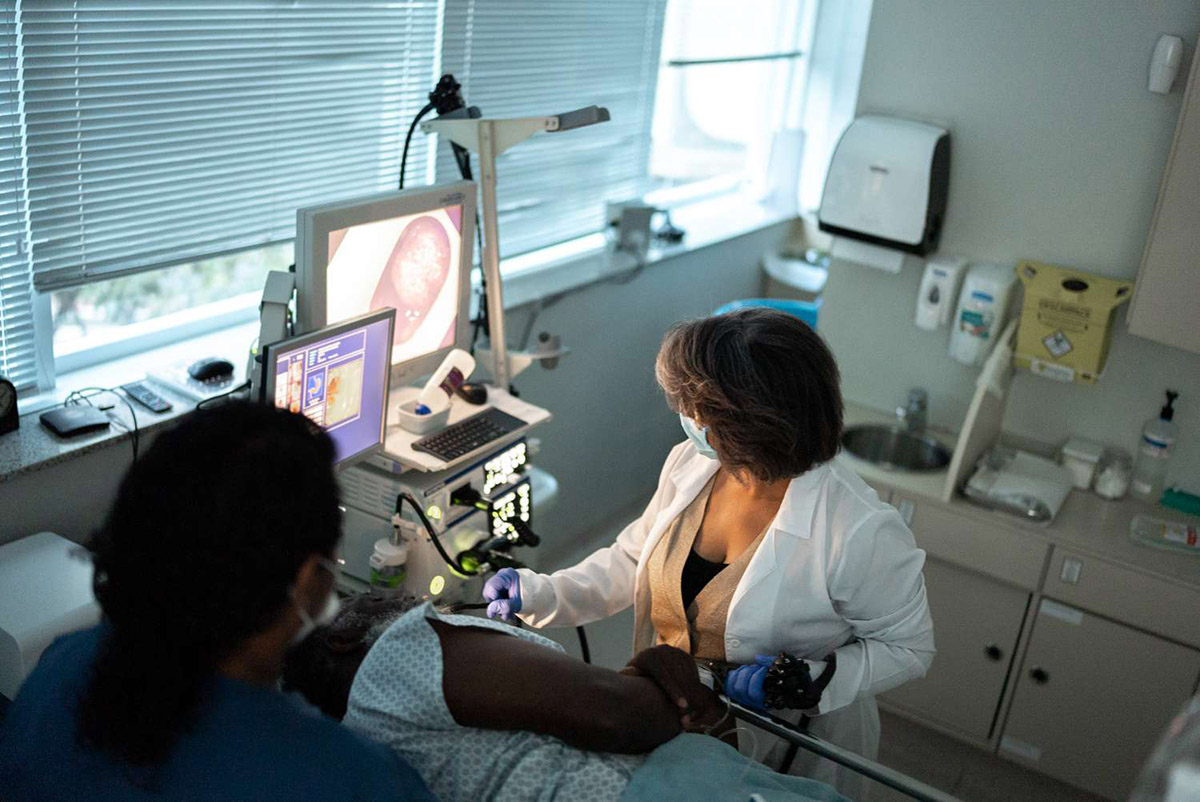

Finance
How Much Is A Colonoscopy Without Insurance?
Published: November 13, 2023
Find out the cost of a colonoscopy without insurance and how to manage your finances for this medical procedure.
(Many of the links in this article redirect to a specific reviewed product. Your purchase of these products through affiliate links helps to generate commission for LiveWell, at no extra cost. Learn more)
Table of Contents
Introduction
Welcome to our comprehensive guide on the cost of colonoscopies without insurance. Whether you’re simply curious about the expenses involved or currently exploring your options for this medical procedure, we’ve got you covered.
Colonoscopies play a crucial role in the early detection and prevention of colorectal cancer, a disease that affects millions of people worldwide. This minimally invasive procedure helps doctors examine the colon for abnormalities, such as polyps or tumors, and can potentially save lives by diagnosing and treating colorectal cancer in its early stages.
However, many individuals are concerned about the financial burden that a colonoscopy may impose, particularly if they do not have health insurance or an insurance plan that covers the procedure. It’s important to understand the cost implications of a colonoscopy and explore ways to mitigate those expenses if you find yourself in this situation.
Throughout this article, we will delve into the various factors that influence the cost of colonoscopies, the average cost of the procedure without insurance, and discuss strategies to reduce the financial burden. Additionally, we will highlight alternative options that may provide more affordable access to this essential preventive healthcare service.
We understand that navigating the complexities of healthcare costs can be overwhelming, so let us be your guide in unraveling the mysteries of colonoscopy expenses. By the end of this article, you’ll have a clearer understanding of the financial aspects associated with colonoscopies and feel empowered to make informed decisions about your healthcare.
Understanding Colonoscopies
Before we delve into the cost of colonoscopies without insurance, let’s first understand what this procedure entails. A colonoscopy is a medical examination that involves the insertion of a long, flexible tube called a colonoscope into the rectum and through the large intestine (colon). This specialized instrument, equipped with a camera and light source, allows a gastroenterologist to visualize the entire colon and check for any abnormalities.
The primary purpose of a colonoscopy is to screen for colorectal cancer, the third most common cancer worldwide. By detecting and removing polyps, which are abnormal growths that can potentially develop into cancer, a colonoscopy can significantly reduce the risk of developing colorectal cancer and increase the chances of early detection.
A colonoscopy is generally recommended for individuals who are 50 years of age and older. If you have a family history of colorectal cancer or any other risk factors, your doctor may recommend the procedure earlier or more frequently.
The procedure itself typically takes about 30 to 60 minutes to complete, although the total time may vary depending on individual circumstances. During the colonoscopy, you will be given sedation to help you relax and make the experience more comfortable.
It’s important to note that a colonoscopy is not limited to cancer screening. It can also be used to investigate various gastrointestinal issues, such as unexplained abdominal pain, changes in bowel habits, rectal bleeding, or inflammatory bowel disease.
Before undergoing a colonoscopy, you will need to follow specific pre-procedure instructions, which typically include dietary restrictions and bowel preparation to ensure that the colon is clear for examination. Your healthcare provider will provide detailed guidelines to follow in the days leading up to the procedure.
Following the colonoscopy, you may experience some mild discomfort or bloating, but this should subside quickly. It’s normal to feel drowsy due to the sedation and you may need someone to accompany you home after the procedure.
Now that we have a better understanding of what a colonoscopy involves, let’s explore the cost factors associated with this important medical procedure.
The Cost of Colonoscopies
When considering the cost of a colonoscopy without insurance, it’s essential to understand the various components that contribute to the overall expenses. The total cost typically comprises the facility fee, which covers the use of the medical facility, equipment, and staff, as well as the professional fee for the gastroenterologist or medical provider performing the procedure.
The cost of a colonoscopy can vary significantly depending on factors such as the geographical location, the healthcare facility, and the complexity of the procedure. In the United States, the average cost ranges from $800 to $3,000.
It’s important to note that the total cost includes not only the procedure itself but also pre- and post-procedure expenses. This includes the initial consultation, any necessary lab tests, sedation, pathology fees if tissue samples are taken, and follow-up appointments.
The cost of a colonoscopy is also influenced by additional factors such as:
- The type of facility: Colonoscopies can be performed in various settings, including hospitals, ambulatory surgical centers, or outpatient clinics. Hospital-based procedures tend to be more expensive due to higher overhead costs.
- Geographical location: The cost of medical procedures can vary significantly depending on the region and local market conditions. Urban areas, where the cost of living is higher, generally have higher medical expenses.
- Healthcare provider: The expertise and reputation of the gastroenterologist or medical provider performing the colonoscopy can also impact the cost. More experienced and renowned specialists may charge higher fees.
- Additional procedures or treatments: If additional interventions are required during the colonoscopy, such as the removal of polyps or tissue biopsies, these may incur additional costs.
It’s worth noting that health insurance coverage plays a significant role in determining the out-of-pocket cost for a colonoscopy. Insurance plans vary widely in terms of coverage, with some fully covering the procedure for preventive screenings, while others may require co-pays, co-insurance, or meeting deductibles. Therefore, it’s crucial to contact your insurance provider and review your policy to understand the extent of coverage and any potential costs you may be responsible for.
Now that we have a better understanding of the factors that contribute to the cost of a colonoscopy, let’s explore the average expenses individuals can expect to encounter without insurance coverage.
Factors Affecting the Cost
The cost of a colonoscopy without insurance can vary depending on several factors that influence the overall expenses. Understanding these factors will help you better grasp the potential financial implications of the procedure. Here are the key factors that can affect the cost:
- Healthcare Facility: The facility where the colonoscopy is performed can significantly impact the cost. Hospitals generally have higher overhead costs, leading to higher fees compared to ambulatory surgical centers or outpatient clinics. Consider exploring different facilities in your area and comparing their pricing.
- Geographical Location: The cost of medical procedures can vary widely based on the region and local market conditions. Urban areas, where the cost of living is higher, tend to have higher medical expenses. It’s possible to find more affordable options in rural or suburban areas.
- Healthcare Provider: The expertise and experience of the gastroenterologist or medical provider performing the colonoscopy can influence the cost. Specialists with more years of experience or reputable names may charge higher fees for their services. It’s recommended to seek recommendations, read reviews, and consider both the quality and cost when selecting a healthcare provider.
- Additional Procedures or Treatments: If extra procedures or treatments are necessary during the colonoscopy, such as the removal of polyps or tissue biopsies, they will incur additional costs. While these additional interventions are essential for diagnosing or treating potential issues, they can impact the overall expenses of the procedure.
- Pre-Procedure Services: The cost of a colonoscopy may also include pre-procedure services, such as the initial consultation, pre-operative tests, and lab work. These services are vital for ensuring the safety and effectiveness of the procedure. Be sure to inquire about any potential costs associated with these services when discussing the colonoscopy with your healthcare provider.
- Post-Procedure Follow-Up: After the colonoscopy, there may be follow-up appointments to review the results, discuss any findings, and address any concerns. These post-procedure services may incur additional costs that need to be factored into the overall expenses.
Keep in mind that these factors may vary depending on your specific situation, geographical location, and healthcare system. It’s recommended to discuss these factors with your healthcare provider and ask for a detailed breakdown of the costs associated with the colonoscopy procedure.
Now that we have explored the factors that can influence the cost of a colonoscopy, let’s move on to understanding the average cost individuals can expect when undergoing this procedure without insurance coverage.
Average Cost of Colonoscopy Without Insurance
When it comes to the cost of a colonoscopy without insurance coverage, it’s important to note that expenses can vary significantly based on several factors we discussed earlier. However, we can provide a general idea of the average cost individuals can expect to encounter.
In the United States, the average cost of a colonoscopy without insurance ranges from $800 to $3,000. This figure includes the facility fee, which covers the use of the medical facility, equipment, and staff, as well as the professional fee for the gastroenterologist or medical provider performing the procedure.
It’s crucial to remember that this average cost is an estimate, and the final expenses may be higher or lower depending on various factors such as geographical location, healthcare facility, and any additional procedures or treatments required during the colonoscopy.
Furthermore, it’s important to consider the potential additional expenses associated with a colonoscopy. Pre-procedure services such as consultations, lab tests, and bowel preparation medications, as well as post-procedure follow-up appointments and any required pathology fees, may also contribute to the overall cost.
While the average cost can provide a general sense of what to expect, it’s always advisable to contact healthcare facilities and providers directly to obtain accurate and up-to-date pricing information specific to your situation. They can provide you with a breakdown of the costs and help you navigate any financial assistance options that may be available.
Now that we have a better understanding of the average cost of a colonoscopy without insurance, let’s explore some strategies to help reduce the financial burden associated with this procedure.
Ways to Reduce the Cost
Dealing with the cost of a colonoscopy without insurance can be overwhelming. However, there are several strategies you can employ to help reduce the financial burden and make the procedure more affordable. Consider the following options:
- Shop around: Research different healthcare facilities and providers to compare costs. Prices can vary significantly between facilities, so it’s worth exploring multiple options in your area. Discuss pricing options and negotiate if possible.
- Consider an ambulatory surgical center: Ambulatory surgical centers generally have lower costs compared to hospitals. If the procedure does not require complex medical facilities or extensive support services, opting for an ambulatory surgical center can be a more cost-effective choice.
- Look for discounted packages: Some medical facilities offer discounted packages for self-pay patients. These packages may include the cost of the procedure, pre-procedure services, and post-procedure follow-up. Inquire about any available discounts or comprehensive packages that can help you save on overall expenses.
- Discuss payment plans and financial assistance: Healthcare facilities and providers may offer payment plans or financial assistance options. Inquire about these options and see if they can help make the cost more manageable for you.
- Explore government programs and local resources: Depending on your location and financial situation, you may qualify for government programs or assistance from local organizations that can help cover the cost of the colonoscopy. Research and reach out to relevant agencies or community resources for information and potential support.
- Consider clinical trials or research studies: Some medical facilities and research institutions conduct clinical trials or research studies related to colonoscopies. These studies often provide free or reduced-cost procedures as part of their research. Look into whether there are any ongoing trials or studies in your area that you may qualify for.
- Discuss alternative options: Depending on your specific circumstances, your healthcare provider may be able to offer alternative screening options for colorectal cancer that are more affordable. While a colonoscopy is considered the gold standard for detecting and preventing colorectal cancer, there are other tests available, such as fecal occult blood tests (FOBT) or stool DNA testing, that may be more cost-effective for some individuals.
Remember, communication is key. Don’t hesitate to discuss your financial concerns openly with your healthcare provider. They may be able to provide guidance, refer you to resources, or even offer discounted rates or payment plans.
By exploring these strategies and being proactive in finding cost-saving methods, you can help reduce the financial burden of a colonoscopy without insurance.
Next, let’s explore other options that may provide more affordable access to colonoscopies.
Other Options for Affordable Colonoscopies
If the cost of a colonoscopy without insurance is still a barrier, there are alternative options to consider that may provide more affordable access to this crucial preventive healthcare service. Explore the following possibilities:
- Community Health Clinics: Community health clinics often offer discounted or low-cost medical services to individuals who are uninsured or have limited financial resources. These clinics may provide colonoscopy screenings at a reduced cost or based on a sliding fee scale.
- Charitable Organizations: Certain charitable organizations or foundations may have programs in place to assist individuals who cannot afford the full cost of a colonoscopy. They may provide financial assistance or connect you with resources to help cover the expenses.
- Hospitals with Financial Assistance Programs: Some hospitals have financial assistance programs in place that can help individuals who do not have insurance or are unable to afford the full cost of medical procedures. These programs can offer reduced fees or even free services based on income eligibility.
- Screening Programs: Look for government-sponsored screening programs or initiatives that aim to provide affordable or free colonoscopies to eligible individuals. These programs are often targeted at specific demographics or individuals with certain risk factors.
- Physician Referrals and Negotiations: Consult with your primary care physician or other medical professionals about the cost concerns you’re facing. They may be able to refer you to facilities or providers who offer more affordable options or help negotiate lower costs on your behalf.
- Medical Tourism: Exploring medical tourism options in countries where healthcare costs are generally lower can be a viable solution for more affordable colonoscopies. However, it’s important to thoroughly research and carefully consider the quality and safety of healthcare facilities and the accessibility of post-procedure care.
It’s crucial to approach these alternative options with caution and thoroughly assess their reliability, safety, and quality. Discuss your situation with your healthcare provider to ensure that any alternative choices align with your specific medical needs and circumstances.
Remember, early detection and prevention of colorectal cancer are paramount, and there are usually options available to help make colonoscopies more affordable. By exploring these alternatives, you can increase the likelihood of accessing this vital preventive healthcare service.
Now that we have discussed various ways to reduce the cost and explore affordable alternatives, let’s summarize our findings.
Conclusion
Navigating the cost of a colonoscopy without insurance can feel overwhelming, but with proper understanding and exploration of available options, you can find ways to make it more affordable. It’s important to remember the significance of a colonoscopy in detecting and preventing colorectal cancer, a disease that can be treated more effectively when caught early.
Throughout this guide, we have explored the factors that affect the cost of a colonoscopy, including the healthcare facility, geographical location, healthcare provider, and any additional procedures or treatments. We have also discussed the average cost range individuals can expect without insurance coverage.
To reduce the financial burden, we have offered strategies such as shopping around, considering ambulatory surgical centers, discussing payment plans and financial assistance, and exploring government programs or local resources. Additionally, we have highlighted alternative options, including community health clinics, charitable organizations, hospitals with financial assistance programs, screening programs, physician referrals and negotiations, and even medical tourism in certain cases.
Remember to communicate openly with your healthcare provider about your financial concerns and explore all available options. Seek out community resources and healthcare programs that may provide financial assistance or reduced-cost services. Taking proactive steps to address the cost can ultimately help you prioritize your health and well-being.
While the cost of a colonoscopy without insurance can be substantial, it’s important to weigh that against the potential health benefits and long-term savings from early detection and prevention of colorectal cancer. Maintaining open communication with healthcare professionals and staying informed about financial assistance options are key to making informed decisions about your healthcare.
Colorectal cancer is a serious disease, but by being proactive and taking steps to screen and monitor your health, you are prioritizing your well-being and increasing the chances of early detection and successful treatment. Don’t let cost be a barrier to receiving this essential preventive healthcare service. Explore your options, seek assistance, and take control of your health.














